Discover 35 hidden attractions, cool sights, and unusual things to do in Madrid (Spain). Don't miss out on these must-see attractions: Palacio Real, Museo del Prado, and Museo Thyssen-Bornemisza. Also, be sure to include Museo Nacional Centro de Arte Reina Sofía in your itinerary.
Below, you can find the list of the most amazing places you should visit in Madrid (Madrid).
Table of Contents
Palacio Real

Official residence in Madrid, Spain. The Royal Palace of Madrid is the official residence of the Spanish royal family at the city of Madrid, although now used only for state ceremonies. The palace has 135,000 m2 of floor space and contains 3,418 rooms. It is the largest functioning royal palace and the largest by floor area in Europe.
The palace is now open to the public, except during state functions, although it is so large that only a selection of rooms are on the visitor route at any one time, the route being changed every few months. An admission fee of €13 is charged; however, at some times it is free. The palace is owned by the Spanish state and administered by the Patrimonio Nacional, a public agency of the Ministry of the Presidency. The palace is on Calle de Bailén ("Bailén Street") in the western part of downtown Madrid, east of the Manzanares River, and is accessible from the Ópera metro station. Felipe VI and the royal family do not reside in the palace, choosing instead the Palace of Zarzuela in El Pardo.
The palace is on the site of a bygone Muslim-era fortress constructed by Emir Muhammad I of Córdoba in the 9th century. The imposing Alcázar of Madrid provided both a safe for the royal treasure and a habitual residence to the Trastámara monarchs in the late middle ages. Having endured substantial expansion works during the 16th century, the royal alcázar remained on the site until it burned down on 24 December 1734. A new palace was thereafter built from scratch on the same site on behalf of the Bourbon dynasty. Construction spanned the years 1738 to 1755 and followed a Berniniesque design by Filippo Juvarra and Giovanni Battista Sacchetti in cooperation with Ventura Rodríguez, Francesco Sabatini, and Martín Sarmiento. During the Second Spanish Republic the building was known as "Palacio Nacional".
The interior of the palace is notable for its wealth of art and the use of many types of fine materials in the construction and the decoration of its rooms. It includes paintings by artists such as Caravaggio, Juan de Flandes, Francisco de Goya, and Velázquez, and frescoes by Giovanni Battista Tiepolo, Corrado Giaquinto, and Anton Raphael Mengs. Other collections of great historical and artistic importance preserved in the building include the Royal Armoury of Madrid, porcelain, watches, furniture, silverware, and the world's only complete Stradivarius string quintet.[1]
Address: Plaza de la Armería, 1, 28013 Madrid (Centro Madrid)
Museo del Prado

World-class European art collection. The Prado Museum, officially known as Museo Nacional del Prado, is the main Spanish national art museum, located in central Madrid. It is widely considered to house one of the world's finest collections of European art, dating from the 12th century to the early 20th century, based on the former Spanish Royal Collection, and the single best collection of Spanish art. Founded as a museum of paintings and sculpture in 1819, it also contains important collections of other types of works. The Prado Museum is one of the most visited sites in the world, and is considered one of the greatest art museums in the world. The numerous works by Francisco Goya, the single most extensively represented artist, as well as by Hieronymus Bosch, El Greco, Peter Paul Rubens, Titian, and Diego Velázquez, are some of the highlights of the collection. Velázquez and his keen eye and sensibility were also responsible for bringing much of the museum's fine collection of Italian masters to Spain, now the largest outside Italy.
The collection currently comprises around 8,200 drawings, 7,600 paintings, 4,800 prints, and 1,000 sculptures, in addition to many other works of art and historic documents. As of 2012, the museum displayed about 1,300 works in the main buildings, while around 3,100 works were on temporary loan to various museums and official institutions. The remainder were in storage.
Due to the COVID-19 pandemic, in 2020 attendance plunged by 76 percent to 852,161. Nonetheless, the Prado was ranked as the 16th most-visited museum in the list of most-visited art museums in the world in 2020. It is one of the largest museums in Spain.
The Prado, with the nearby Thyssen-Bornemisza Museum and the Museo Reina Sofía, forms Madrid's Golden Triangle of Art, which was included in the UNESCO World Heritage list in 2021.[2]
Address: Paseo del Prado, s/n, 28014 Madrid (Retiro)
Museo Thyssen-Bornemisza
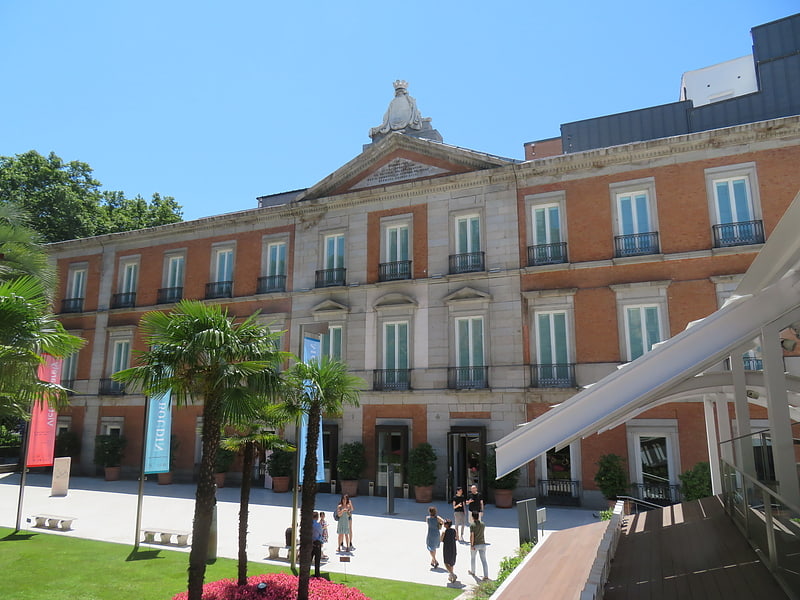
European art from 13th to 20th centuries. The Thyssen-Bornemisza National Museum, or simply the Thyssen, is an art museum in Madrid, Spain, located near the Prado Museum on one of the city's main boulevards. It is known as part of the "Golden Triangle of Art", which also includes the Prado and the Reina Sofia national galleries. The Thyssen-Bornemisza fills the historical gaps in its counterparts' collections: in the Prado's case this includes Italian primitives and works from the English, Dutch and German schools, while in the case of the Reina Sofia it concerns Impressionists, Expressionists, and European and American paintings from the 20th century.
With over 1,600 paintings, it was once the second largest private collection in the world after the British Royal Collection. A competition was held to house the core of the collection in 1987–88 after Baron Thyssen, having unsuccessfully sought permission to enlarge his Museum in Lugano (Villa Favorita), searched for a better-suited location elsewhere in Europe.[3]
Address: Paseo del Prado, 8, 28014 Madrid (Centro Madrid)
Museo Nacional Centro de Arte Reina Sofía

Museum in Madrid, Spain. The Museo Nacional Centro de Arte Reina Sofía is Spain's national museum of 20th-century art. The museum was officially inaugurated on September 10, 1990, and is named for Queen Sofía. It is located in Madrid, near the Atocha train and metro stations, at the southern end of the so-called Golden Triangle of Art.
The museum is mainly dedicated to Spanish art. Highlights of the museum include excellent collections of Spain's two greatest 20th-century masters, Pablo Picasso and Salvador Dalí. The most famous masterpiece in the museum is Picasso's 1937 painting Guernica. Along with its extensive collection, the museum offers a mixture of national and international temporary exhibitions in its many galleries, making it one of the world's largest museums for modern and contemporary art. In 2020, due to the COVID-19 pandemic it attracted only 1,248,480 visitors, a drop of 72 percent from 2019, but it still ranked sixth on the list of most-visited art museums in the world.
It also hosts a free-access library specializing in art, with a collection of over 100,000 books, over 3,500 sound recordings, and almost 1,000 videos.[4]
Address: Calle de Santa Isabel, 52, 28012 Madrid (Centro Madrid)
Zoo Aquarium de Madrid
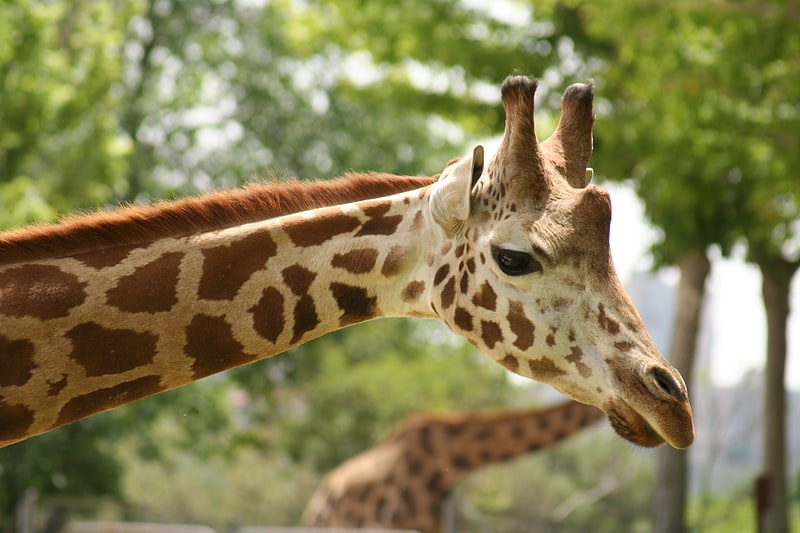
Also known as: Parque zoológico de Madrid
Land and sea animals from around the world. The Madrid Zoo Aquarium is a 20-hectare zoo and aquarium located in the Casa de Campo in Madrid, Spain. The zoo is owned by the city, but is managed by the international entertainment operator Parques Reunidos. Opened in 1770, it is one of the largest zoos in Spain and one of the few zoos in the world that houses giant pandas.
The zoo is a member of the European Association of Zoos and Aquaria (EAZA) and the World Association of Zoos and Aquariums (WAZA).[5]
Address: Casa de Campo, 28011 Madrid (Moncloa - Argüelles)
Palacio de Cristal
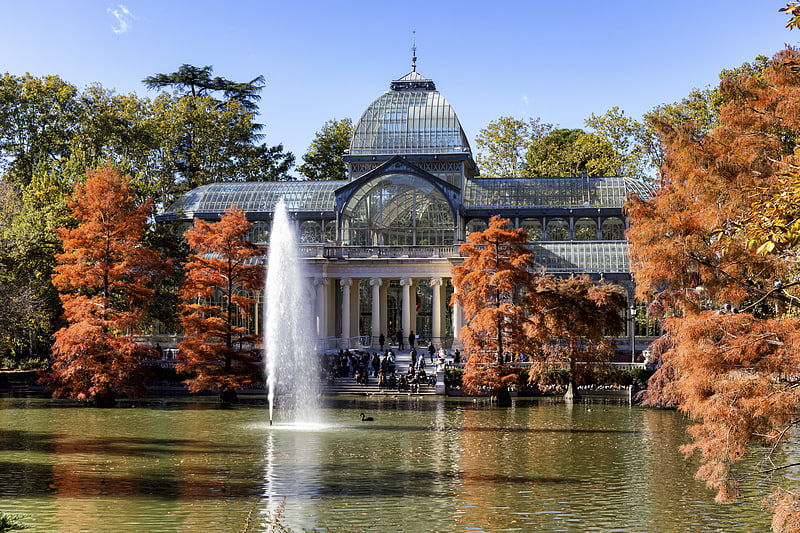
1887 glasshouse housing contemporary art. The Palacio de Cristal is a conservatory located in Madrid's Buen Retiro Park.
The Palacio de Cristal, in the shape of a Greek cross, is made almost entirely of glass set in an iron framework on a brick base, which is decorated with ceramics. Its cupola makes the structure over 22 metres high. When it was erected, glass and iron construction on a large scale was already to be seen in Madrid at Delicias station (1880), the work of a French architect; however, the curved architecture of the Palacio de Cristal is more comparable to the techniques pioneered by the British architects Joseph Paxton (who was responsible for London's Crystal Palace) and Decimus Burton (who was responsible for the Palm House at Kew Gardens). The Palacio de Cristal was, alongside the Pabellón Central, one of the main venues of the 1887 Philippines Exposition.
The cast-iron frame was manufactured in Bilbao. The structure was designed in a way that would allow it to be re-erected on another site (as happened to the equivalent building in London). However, the building has remained on the original site, next to a lake, and has been restored to its original appearance. It is no longer used as a greenhouse, and is currently used for art exhibits.[6]
Address: Parque Del Retiro, 28009 Madrid Madrid (Retiro)
Plaza Mayor
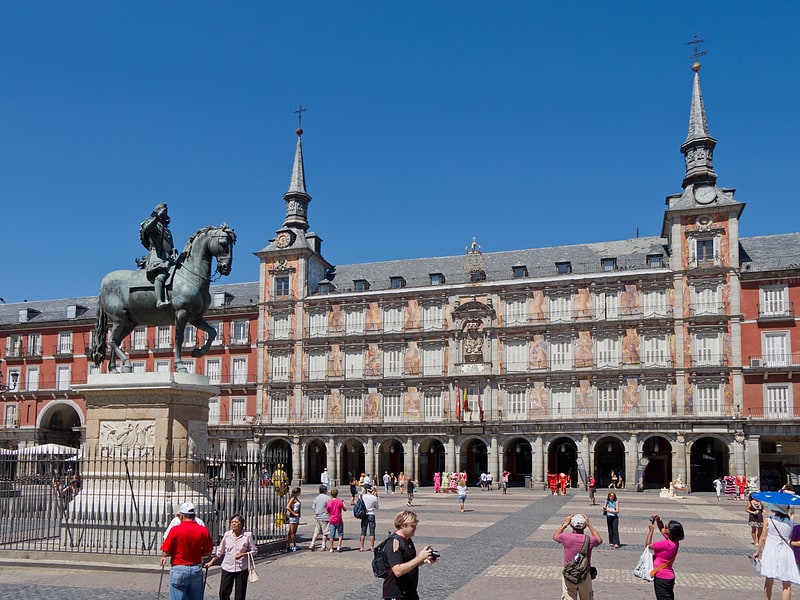
Madrid's vibrant main square. The Plaza Mayor is a major public space in the heart of Madrid, the capital of Spain. It was once the centre of Old Madrid. It was first built during the reign of Philip III. Only a few blocks away is another famous plaza, the Puerta del Sol. The Plaza Mayor is a space for the people of Madrid and tourists to shop, walk around, eat, and enjoy the outdoors.[7]
Address: Plaza Mayor, 28012 Madrid (Centro Madrid)
Museo Nacional de Ciencias Naturales

Animal and plant exhibits on 5 levels. The National Museum of Natural Sciences is the national museum of natural history of Spain. It is situated in the center of Madrid, by the Paseo de la Castellana. It is managed by the Spanish National Research Council.[8]
Address: Calle de José Gutiérrez Abascal, 2, 28006 Madrid (Chamartín)
Gran Vía
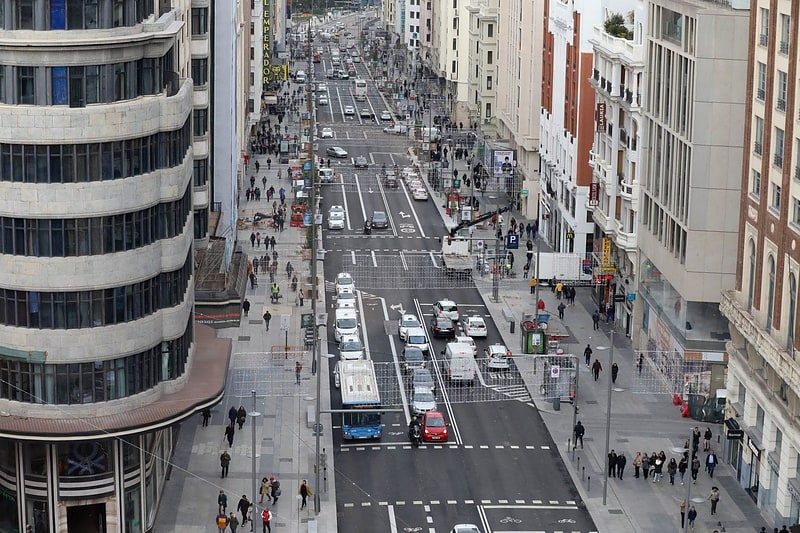
Famed street for shopping and dining. The Gran Vía street is a street in central Madrid, Spain. It leads from Calle de Alcalá, close to Plaza de Cibeles, to Plaza de España. The street, sometimes referred to as the "Spanish Broadway", is one of the city's most important shopping areas, with a large number of hotels and large movie theatres; however, since the late 2000s, many of these theatres have been replaced by shopping centres.
The Gran Vía serves as a showcase of early 20th-century revival architecture, with architectural styles ranging from Vienna Secession style, Plateresque, Neo-Mudéjar, Art Deco, among others.[9]
Address: Calle Gran Vía, Madrid (Centro Madrid)
Real Jardín Botánico de Madrid
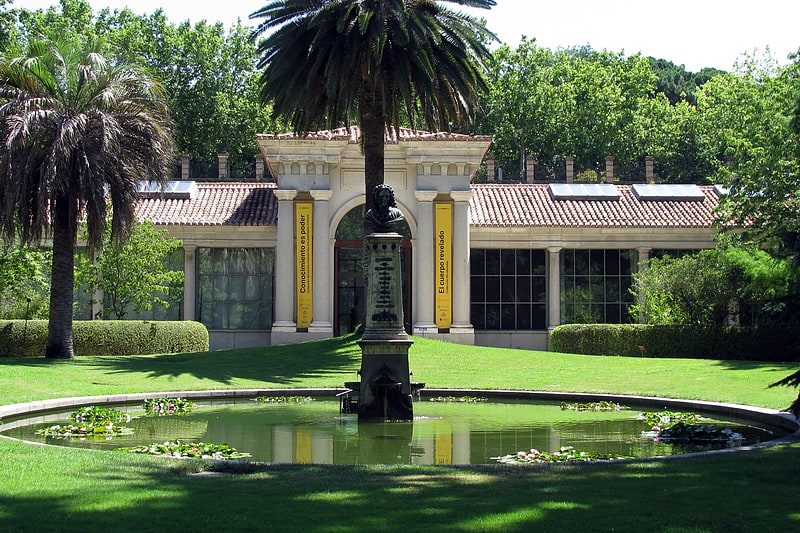
Royal botanical garden with trails. Real Jardín Botánico de Madrid is an 8 hectares botanical garden in Madrid. The public entrance is located at Plaza de Murillo, next to the Prado Museum.[10]
Address: Plaza de Murillo, 2, 28014 Madrid (Retiro)
Templo de Debod

Reconstructed ancient Egyptian temple. The Temple of Debod is an ancient Egyptian temple that was dismantled and rebuilt in the center of Madrid, Spain, in Parque de la Montaña, Madrid, a square located Calle de Irún, 21–25 Madrid.[11]
Address: Calle de Ferraz, 1, 28008 Madrid (Moncloa - Argüelles)
Palace of Linares
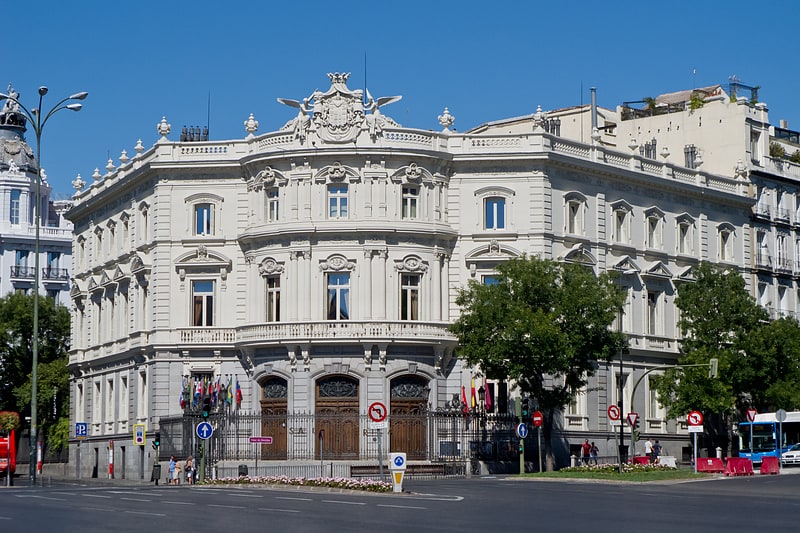
Also known as: Palacio de Linares
Palace in Madrid, Spain. The Palace of Linares is a palace located in Madrid, Spain. It was declared national historic-artistic monument in 1976. Located at the plaza de Cibeles. It is the seat of the Casa de América.[12]
Address: Plaza Cibeles, 2, 28001 Madrid (Salamanca)
CaixaForum Madrid
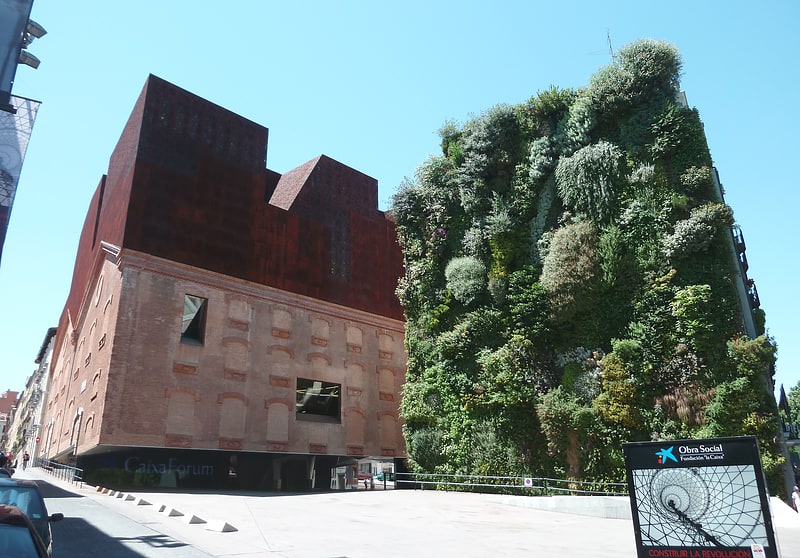
Museum in Madrid, Spain. CaixaForum Madrid is a museum and cultural center in Paseo del Prado 36, Madrid. It is sponsored by Caixa Bank.
It was designed by the Swiss architects Herzog & de Meuron and built by Ferrovial between 2001 and 2007. It was an old power station called Central Del Mediodía, from the 1900s. The Vertical Garden at the square is also well-known.[13]
Address: Paseo de Recoletos, 28014 Madrid (Centro Madrid)
Puerta del Sol
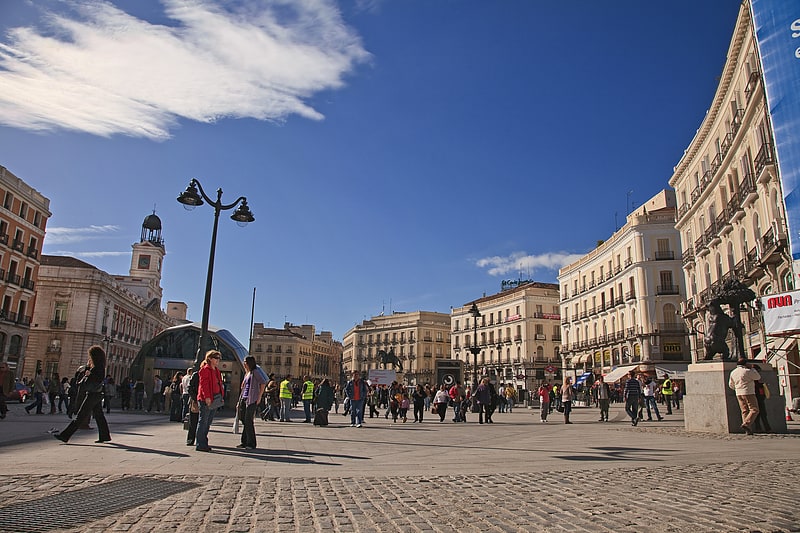
Plaza in Madrid, Spain. The Puerta del Sol is a public square in Madrid, one of the best known and busiest places in the city. This is the centre of the radial network of Spanish roads. The square also contains the famous clock whose bells mark the traditional eating of the Twelve Grapes and the beginning of a new year. The New Year's celebration has been broadcast live since 31 December 1962 on major radio and television networks including Atresmedia and RTVE.[14]
Address: Plaza de la Puerta del Sol, s/n, 28013 Madrid (Centro Madrid)
Plaza de Cibeles
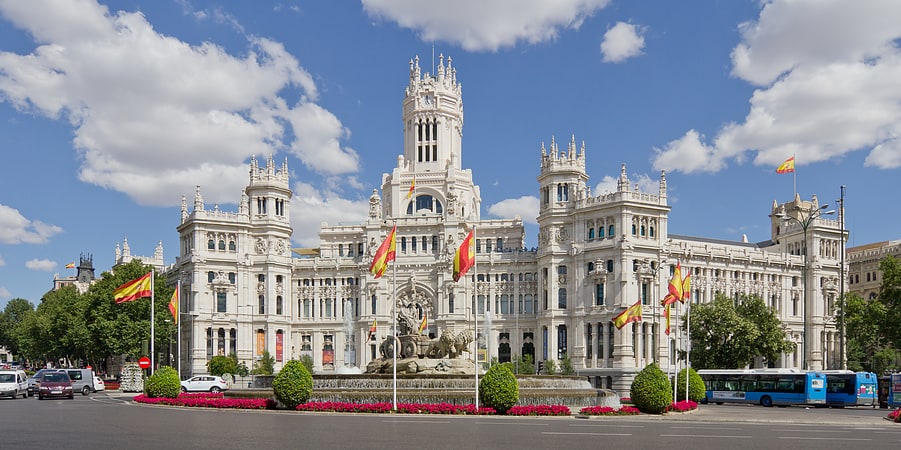
The Plaza de Cibeles is a square with a neo-classical complex of marble sculptures with fountains that has become a symbol for the city of Madrid. It sits at the intersection of Calle de Alcalá, Paseo de Recoletos and Paseo del Prado. Plaza de Cibeles was originally named Plaza de Madrid, but in 1900, the City Council named it Plaza de Castelar, which was eventually replaced by its current name.
It is currently delimited by four prominent buildings: the Bank of Spain Building, the Palacio de Buenavista, the Palace of Linares ("Palacio de Linares"), and the Cybele Palace ("Palacio de Cibeles"). These constructions are located in four different neighbourhoods from three different adjacent districts: Centro, Retiro, and Salamanca.
Over the years, Cybele Palace and her fountain have become symbolic monuments of the city.[15]
Address: Plaza Cibeles, 1A, 28014 Madrid (Centro Madrid)
Monument to Miguel de Cervantes
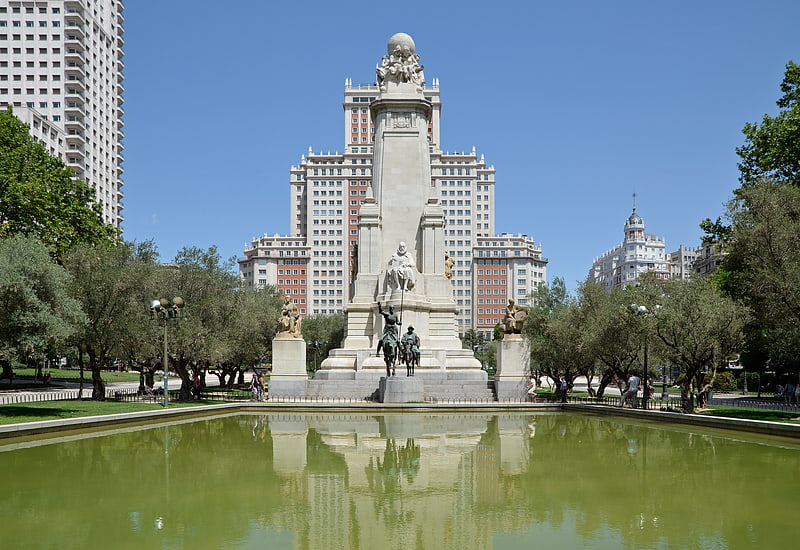
The Monument to Miguel de Cervantes is an instance of public art located in Madrid, Spain. Erected on the centre of the Plaza de España, it is dedicated to Miguel de Cervantes, widely regarded as the greatest writer in the Spanish language. The monument incorporates a stone monolith with several statues and a detached bronze sculptural group representing Don Quixote and Sancho Panza.[16]
Royal Palace of El Pardo
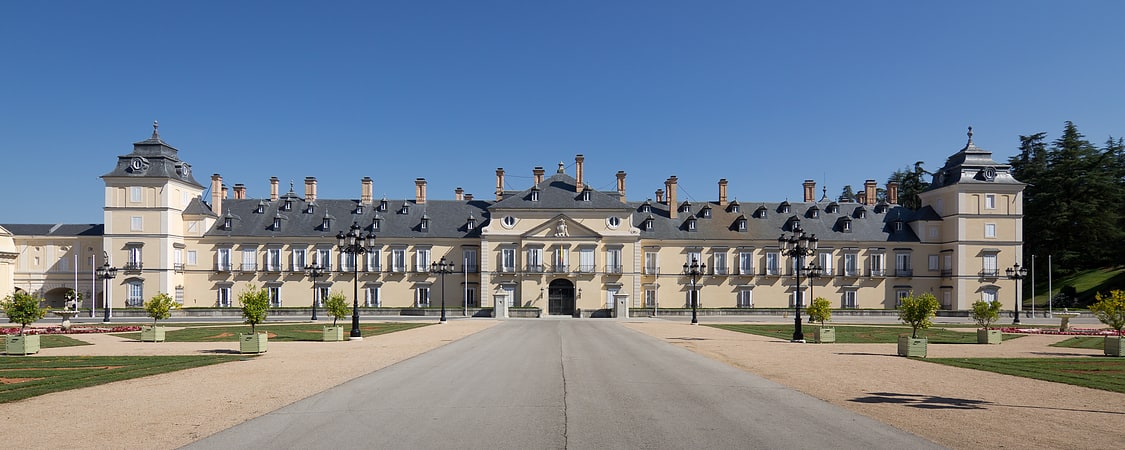
Also known as: Palacio Real de El Pardo
Building in Spain. The Royal Palace of El Pardo is a historic building in Madrid, Spain, in the present-day district of Fuencarral-El Pardo. It is owned by the Spanish state and administered by the Patrimonio Nacional agency. It serves as the state guest house of the Spanish Government.[17]
Address: Calle Manuel Alonso, s/n, 28048 Madrid (El Pardo)
National Archaeological Museum
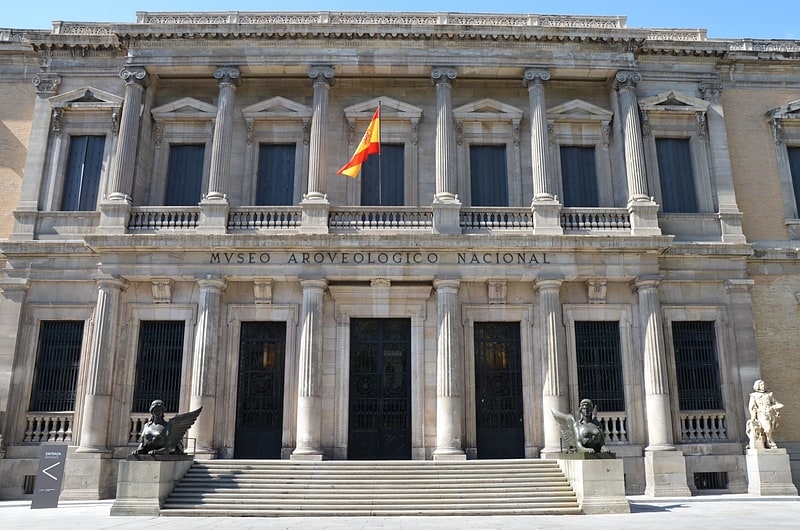
Also known as: Museo Arqueológico Nacional
Museum in Madrid, Spain. The National Archaeological Museum is a museum in Madrid, Spain. It is located on Calle de Serrano beside the Plaza de Colón, sharing its building with the National Library of Spain.[18]
Address: Calle Serrano 13, 28001 Madrid (Salamanca)
Fountain of Neptune
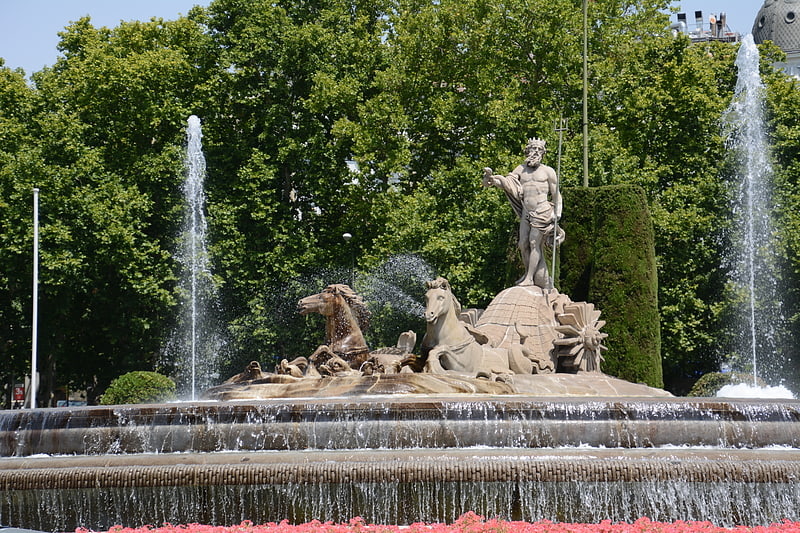
Sculpture by Juan Pascual de Mena and Ventura Rodríguez. The Fountain of Neptune is a neoclassical fountain located in Madrid, Spain. It lies on the centre of the Plaza de Cánovas del Castillo, a roundabout in the Paseo del Prado. The sculptural group in its centre represents Neptune, a Roman water deity.[19]
Address: C. Cervantes, 42, 28014 Madrid (Centro Madrid)
Museo de América
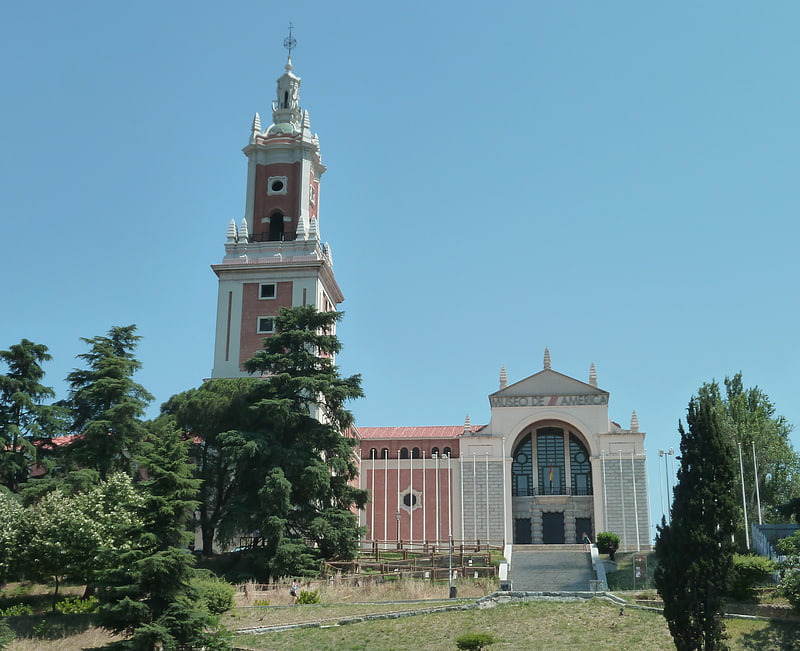
American art, archaeology and ethnography. The Museo de América is a Spanish national museum of arts, archaeology and ethnography in Madrid. Its collections cover the whole of the Americas and range from the Paleolithic period to the present day.
It is owned by the Spanish State and its initial pieces came from the former collection of American archaeological and ethnographic artifacts from the National Archaeological Museum, also exhibiting a number of unrelated donations, deposits and purchases.[20]
Address: Av. de los Reyes Católicos, 6, 28040 Madrid (Moncloa - Argüelles)
Almudena Cathedral
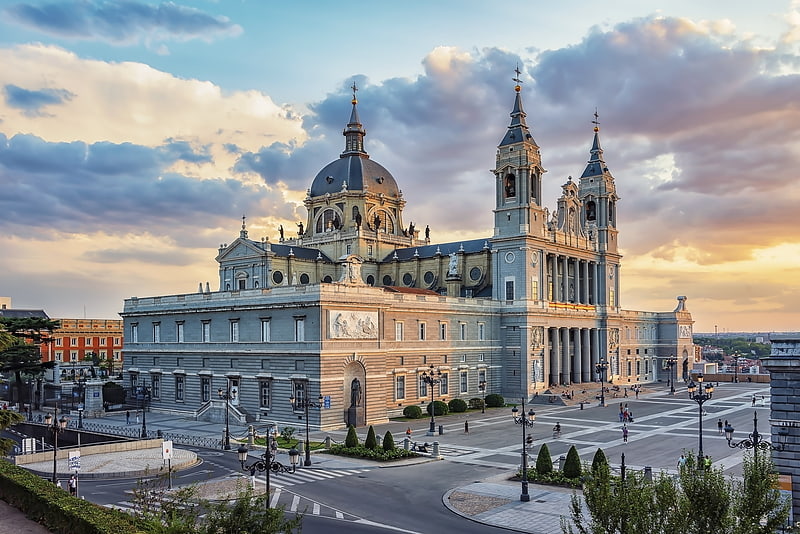
Also known as: Catedral de la Almudena
Catholic cathedral with striking chapels. Almudena Cathedral is a Catholic church in Madrid, Spain. It is the seat of the Roman Catholic Archdiocese of Madrid. The cathedral was consecrated by Pope John Paul II in 1993.[21]
Address: Calle Mayor, 90, 28013 Madrid (Centro Madrid)
Monument to Claudio Moyano

The Monument to Claudio Moyano is an instance of public art in Madrid, Spain. Designed by Agustín Querol and located at the Plaza del Emperador Carlos V, it consists of a bronze statue of Claudio Moyano, a 19th century statesman noted for the authorship of the 1857 Law of Education, put on top of a tall stone pedestal.[22]
Address: Claudio Moyano, s/n, 28014 Madrid (Retiro)
Lavapiés
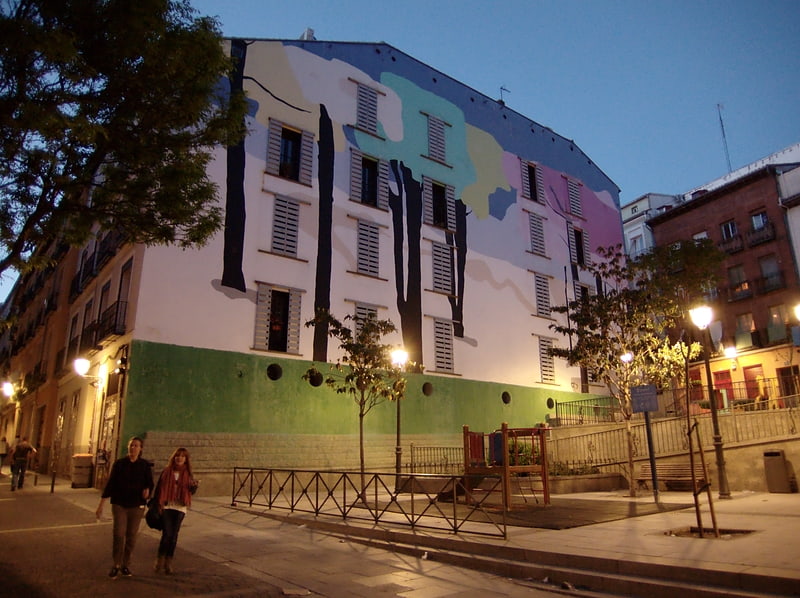
Neighbourhood in Madrid, Spain. Lavapiés is a historic neighbourhood in the city of Madrid, Spain. It is located in the administrative ward of Embajadores in the downtown Centro District, southwest of neighbouring neighbourhood La Latina.
The name literally means "wash feet" possibly in the fountain in Plaza de Lavapiés which no longer exists.[23]
Puerta de Alcalá
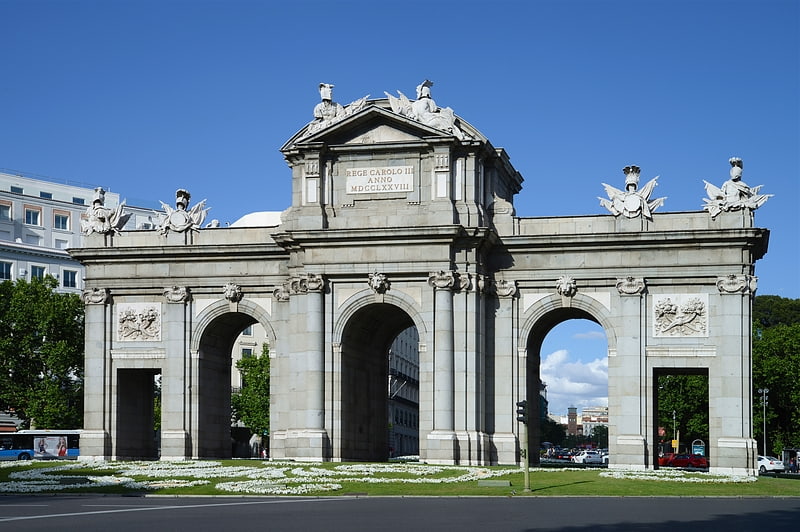
Neoclassical 5-arched triumphal gateway. The Puerta de Alcalá is a Neo-classical gate in the Plaza de la Independencia in Madrid, Spain.
It was a gate of the former Walls of Philip IV. It stands near the city center and several meters away from the main entrance to the Parque del Buen Retiro. The square is bisected by Alcalá Street, although the street does not cross through the monument, and it is the origin of the Alfonso XII, Serrano and Olózaga streets. Its name originates from the old path from Madrid to the nearby town of Alcalá de Henares.
Madrid in the late 18th century still looked like a somewhat drab borough, surrounded by medieval walls. Around the year 1774, King Charles III commissioned Francesco Sabatini to construct a monumental gate in the city wall through which an expanded road to the city of Alcalá was to pass, replacing an older, smaller, gate that stood nearby. It was inaugurated in 1778.
The ornamental details were sculpted by Francisco Gutiérrez and Roberto Michel, and made of white stone from Colmenar. The architectural elements are chiefly made of granite from Segovia.
The central plaque reads rege carolo iii anno mdcclxxviii.[24]
Address: Plaza Independencia 1, 28001 Madrid (Salamanca)
Real Armería
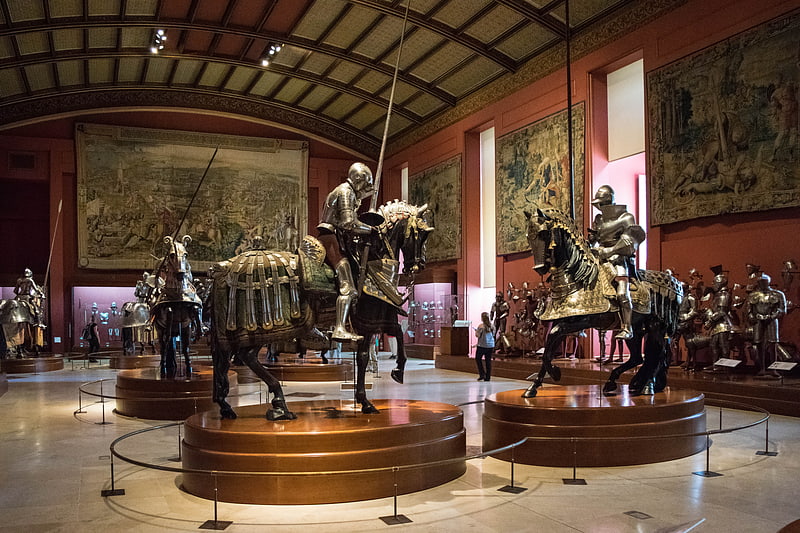
Museum in Madrid, Spain. The Royal Armoury of Madrid or Real Armería de Madrid, is a collection that, among many other things, contains the personal arms of the Kings of Spain, and also houses military weapons, armours and diplomatic works of art like mixed tapestries, paintings and other works of art and trophies. Among the most notable parts of the collection are armor and full tools that Charles V, Holy Roman Emperor and Philip II used. It is considered, along with the Imperial Armory of Vienna, one of the best in the world.
The decision to grant preferential treatment to the Armory dates back at least to the death of Charles V, Holy Roman Emperor, which occurred on 21 September 1558.[25]
Address: Calle de Bailén, s/n, 28013 Madrid (Centro Madrid)
Casón del Buen Retiro
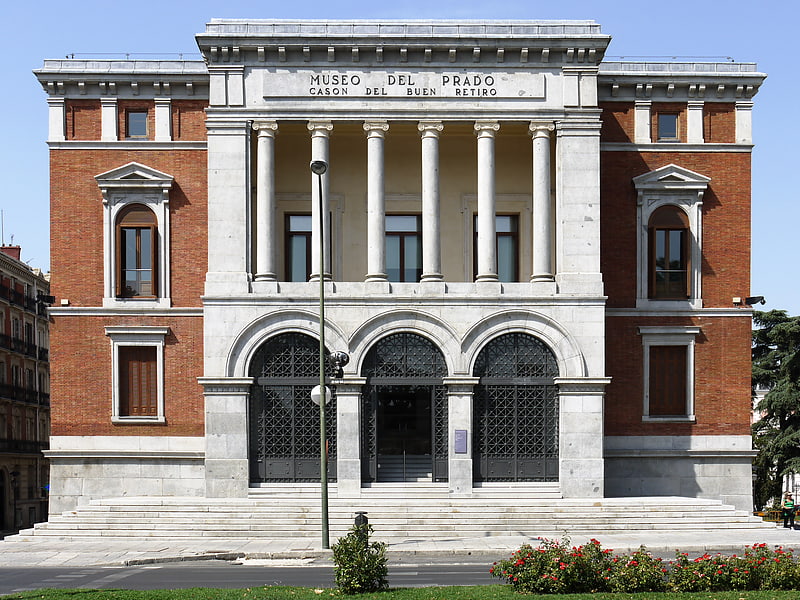
Museum in Madrid, Spain. The Casón del Buen Retiro is an annex of the Museo del Prado complex in Madrid. Following major restoration work, which was completed in October 2007, it now houses the Museum's study centre and library.
Picasso's 1937 Guernica canvas, and the sketches associated with its creation, were on display at the Casón from 1981, when it was delivered to Spain from New York's Museum of Modern Art (MoMA), to 1992, when it was moved to its current permanent location in a purpose-built gallery at the Museo Nacional Centro de Arte Reina Sofía.[26]
Address: Calle de Alfonso XII, 28, 28014 Madrid (Retiro)
Muslim Walls of Madrid
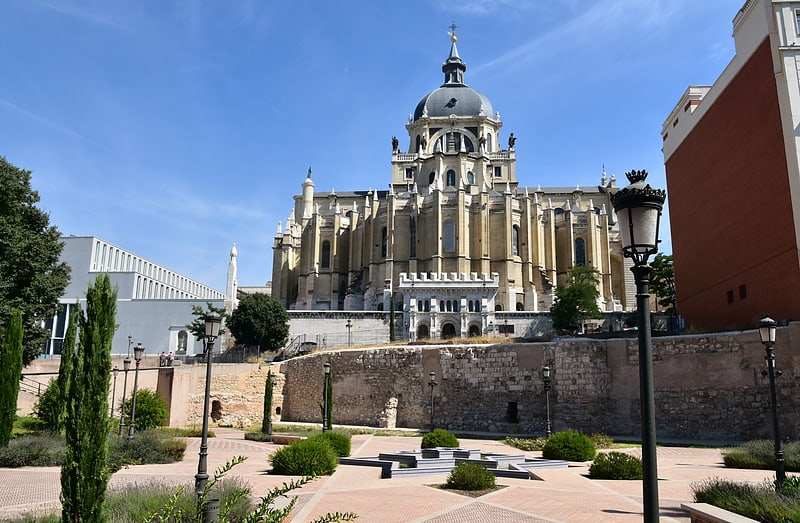
Also known as: Muralla musulmana de Madrid
Historical landmark in Madrid, Spain. The Muslim Walls of Madrid, of which some vestiges remain, are located in the Spanish city of Madrid. They are probably the oldest construction extant in the city. They were built in the 9th century, during the Muslim domination of the Iberian Peninsula, on a promontory next to Manzanares river. They were part of a fortress around which developed the urban nucleus of Madrid. They were declared an Artistic-Historic Monument in 1954.
The remains of utmost importance, with more archaeological than artistic interest, are in the Cuesta de la Vega, next to the crypt of the Almudena Cathedral. They were built in the park of Mohamed I, named in reference to Muhammad I of Córdoba, considered the founder of the city.
Along the Calle Mayor street, at number 83, next to the Viaduct that serves the Calle de Segovia, are still standing the ruins of the Tower of Narigües, which probably would have been an albarrana tower, with a separate location from the main wall itself, but connected thereto by a minor wall. Its function was to serve as a viewpoint.
In the 20th century, some remains were destroyed. The rest once existing near number 12 Calle de Bailén were lost with the construction of an apartment block, although some walls were integrated into the building structure as its foundation. The remodeling of the Plaza de Oriente, completed in 1996 during the mayoral term of José María Álvarez del Manzano, meant the discovery and subsequent disappearance of numerous remains. This was not the case with the watchtower known as Tower of the Bones, whose base is on display in the underground car park of the same plaza.
Between 1999 and 2000, another section was uncovered, about 70 metres (230 ft) long, under the Plaza de la Armería, formed by the main façades of the Royal Palace and Almudena Cathedral. It was excavated during the construction work of the Museum of Royal Collections (unfinished) and may correspond to the Puerta de la Sagra, one of the gates to the walled enclosure.[27]
Address: Cuesta de la Vega, 28013 Madrid (Centro Madrid)
El Rastro
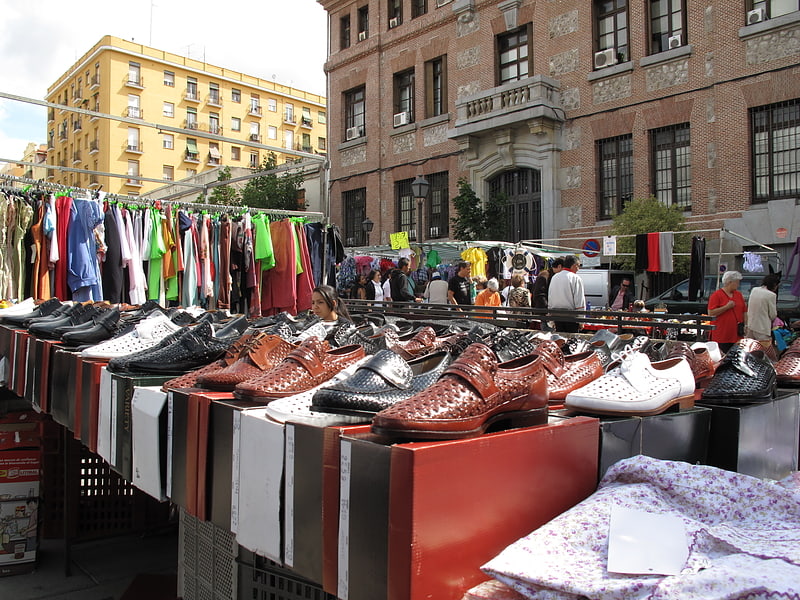
Historic flea market held every Sunday. El Rastro de Madrid or simply el Rastro is the most popular open air flea market in Madrid. It is held every Sunday and public holiday during the year and is located along Plaza de Cascorro and Ribera de Curtidores, between Calle Embajadores and the Ronda de Toledo.
A great variety of products (new and used) can be found at el Rastro. A number of antique shops in the local area are also open on Sunday.[28]
Address: Plaza de Cascorro, 28005 Madrid (Centro Madrid)
Faunia

Zoo in Madrid, Spain. Faunia is a zoo and a botanical garden located in Madrid, Spain. It covers about fourteen square hectares and is organized into areas representing different ecosystems, such as jungle, polar regions, and African forest. It is owned by Parques Reunidos, SA.
Faunia was opened on July 10, 2001 under the name Parque Biológico de Madrid. In 2002, the park was renamed Faunia, a name created by the philologist and writer, Fernando Beltrán. The author of the project was Ricardo Novaro Bocco..
In 2014, Faunia received 400,867 visitors.[29]
Address: Avenida Comunidades 28, 28032 Madrid
Puerta de San Vicente
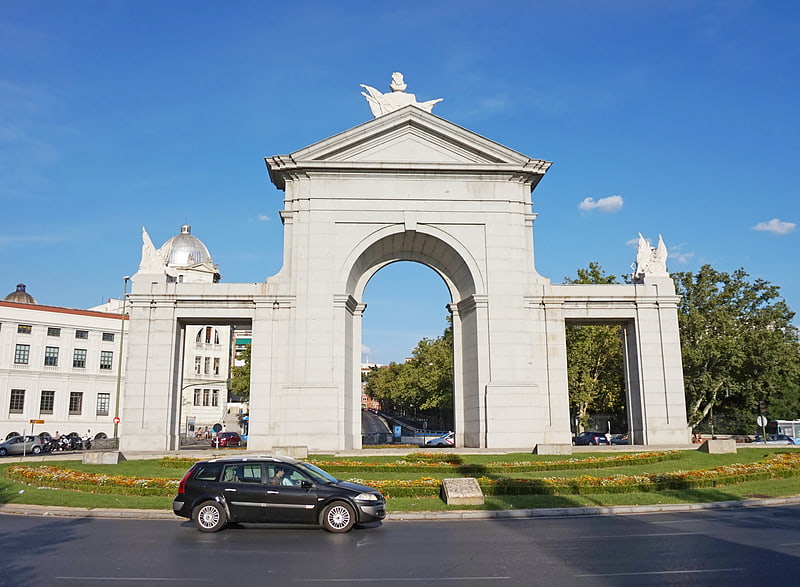
Monument in Madrid, Spain. The Puerta de San Vicente is a monumental gate located in the Glorieta de San Vicente in Madrid. Since 1995, it has occupied the space where the original door, designed by architect Francesco Sabatini, was located between 1775 and 1892.[30]
Metropolis Building

Also known as: Edificio Metrópolis
Office in Madrid, Spain. The Metropolis Building or Edificio Metrópolis is an office building in Madrid, Spain, at the corner of the Calle de Alcalá and Gran Vía. Inaugurated in 1911, it was designed by Jules and Raymond Février for the insurance company La Unión y el Fénix. It is currently owned by Metrópolis Seguros.[31]
Mercado de San Miguel
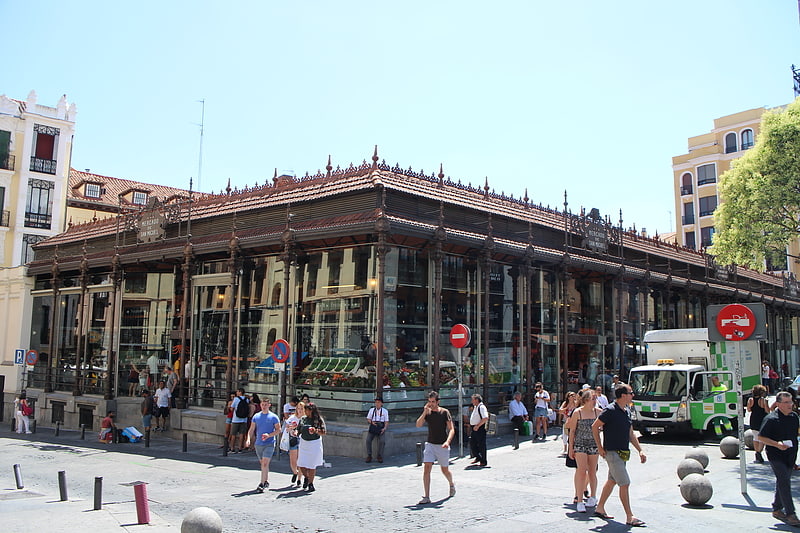
Market in Madrid, Spain. The Market of San Miguel is a covered market located in Madrid, Spain. Originally built in 1916, it was purchased by private investors in 2003 who renovated the iron structure and reopened it in 2009.[32]
Address: Plaza de San Miguel, s/n, 28005 Madrid (Centro Madrid)
Teatro Fernán Gómez
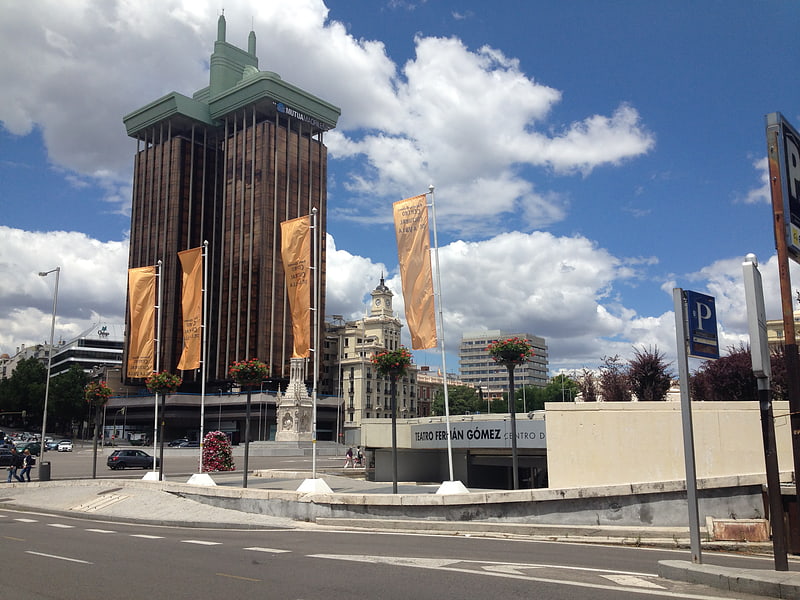
The Teatro Fernán Gómez is a theatre and cultural centre in Madrid, Spain.[33]
Address: Calle Marques de La Ensenada 14, 28004 Madrid (Salamanca)
Medialab-Prado
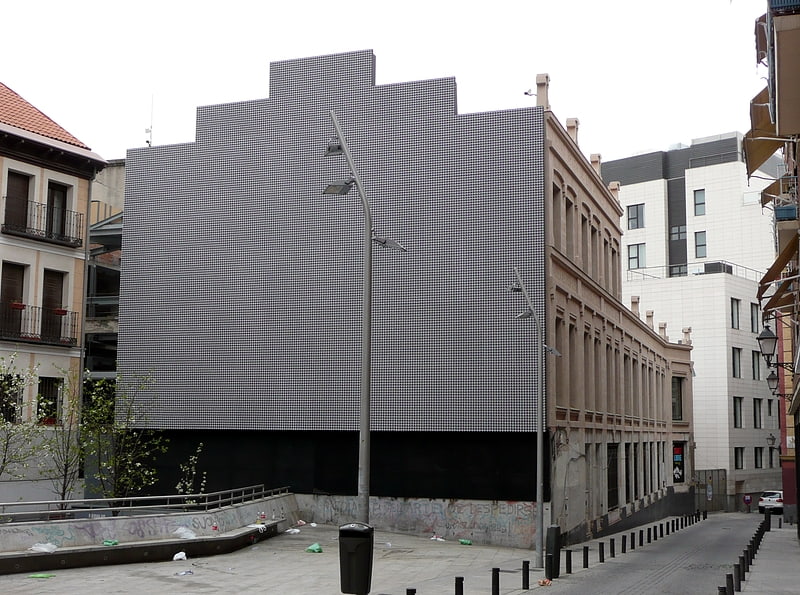
The Medialab-Prado, sometimes abbreviated MLP, is a cultural space and citizen lab in Madrid. It was created by the Madrid City Council in 2000, growing since then into a leading center for citizen innovation. It follows a participatory approach, using collective intelligence methods and fast prototyping tools such as fab labs, to use and co-create digital commons.[34]
Address: Calle de La Alameda 15, 28014 Madrid (Centro Madrid)
El Capricho Park
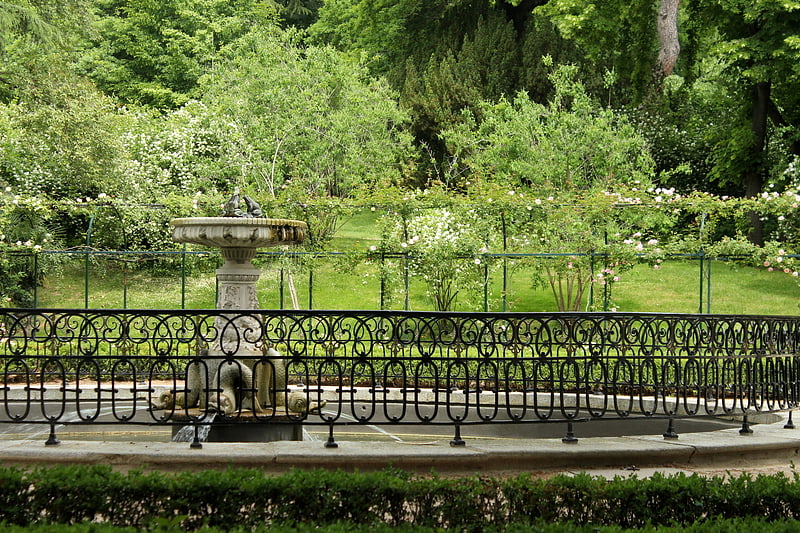
Also known as: Parque de El Capricho
Park in Madrid, Spain. El Capricho is a park in Madrid. The name capricho means "folly" in Spanish. It was created by María Josefa Pimentel, Duchess of Osuna on her estate at Alameda de Osuna, which was then outside the city of Madrid. It is landscaped in eighteenth-century style with formal and naturalistic features. It is recognised as one of the most beautiful parks in the city.
The landscape design shows some English influence. Characteristically of continental gardens in the English style, there are a number of "eye-catchers" such as a hermit's house and a temple to Bacchus. Other features include a lake and a maze.[35]
Address: Paseo de la Alameda de Osuna, 29, 28042 Madrid (Barajas)